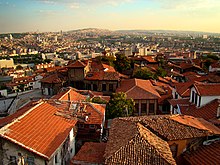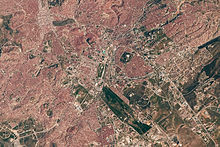Ankara
This is the sighted version that was marked on May 24, 2021. There are 3 pending changes that still need to be sighted.
![]()
The title of this article is ambiguous. For other meanings, see Ankara (disambiguation).
Template:Infobox Place in Turkey/Maintenance/CountyWithoutInhabitantsOrArea
Ankara [ˈaŋkara], formerly Angora (ancient Greek name Ἄγκυρα Ankyra, Latin Ancyra), has been the capital of Turkey and the eponymous province of Ankara since 1923.
The city, which under Turkish law is constituted as a metropolitan municipality (Büyükşehir Belediyesi) and is now identical in area and population to the province of the same name, had a population of about 5.7 million in 2020, making it the second largest city in the country after Istanbul.

View from the citadel to the old town
Etymology and name of the city
The exact etymological origin of the name Ankara is not known. Pausanias reports that King Midas found an anchor at the site and then founded the city there according to the object as Ankyra (Greek for anchor). Stephanos of Byzantium claims that the Galatians, fighting the Ptolemies from Egypt, brought back an anchor as a war trophy after their victory and perpetuated this designation in the city's name when it was founded. Coinages with an anchor motif are known. On the other hand, there are indications that the city name was already used in a similar form since the Phrygians or even the Hittites and was later changed to Ankyra by the Greeks.
Similarly, during the Islamic period of Ankara, it was theorized that the name of the city, then called Engürü, derived from the Persian word for grape (engûr), which referred to the lush vineyards around Ankara.
As of March 28, 1930, the Turkish name Ankara was also enforced for the name of the capital in dealings with Europeans in place of the form of the name Angora, which had hitherto been customary among Europeans in the Latin script and originated in modern Greek. Older Turkish forms of the name were Engüriye, Engürü, or Engüri; earlier forms of the name were Greek Ankyra, Latin Ancyra, and Arabic Anḳira and Anḳuriyya or Ḳalʿat al-Salāsil, in German "Kettenfestung".
Geography and climate
Ankara is located about 900 to 1050 meters above sea level and has a severe dry continental climate characterized by hot dry summers and cold snowy winters. The city lies south at the foot of the Köroğlu Mountains and stretches south towards the Konya Plateau. The average annual temperature is 12.6 °C. The warmest months are July and August with an average of just over 24 °C, and the coldest are January and February with temperatures just above freezing. The most precipitation falls in May with an average of 51 millimetres, the least precipitation is recorded for the months of July and August with an average of just under 15 millimetres. The annual total of precipitation is 414 mm on average, making Ankara one of the driest areas in Turkey.
In the city, two small streams named Hatip Çayı, also called Bent Deresi, and Çubuk Çayı join to form the Ankara River (Ankara Çayı), which is mostly overbuilt and heavily polluted in the city.
| Ankara, Keçiören (891 m) | ||||||||||||||||||||||||||||||||||||||||||||||||
| Climate diagram | ||||||||||||||||||||||||||||||||||||||||||||||||
| ||||||||||||||||||||||||||||||||||||||||||||||||
| Monthly average temperatures and precipitation for Ankara, Keçiören (891 m)
Source: MGM, normal period 1991-2020 | |||||||||||||||||||||||||||||||||||||||||||||||||||||||||||||||||||||||||||||||||||||||||||||||||||||||||||||||||||||||||||||||||||||||||||||||||||||||||||||||||||||||||||||||||||||||||||||||||||||||||||||||||||||||||||||||||||||||||||||

Satellite photo. The cardinal points are tilted about 135 degrees to the left compared to the usual north orientation on maps, i.e. the lower left corner points approximately to the north.
Search within the encyclopedia